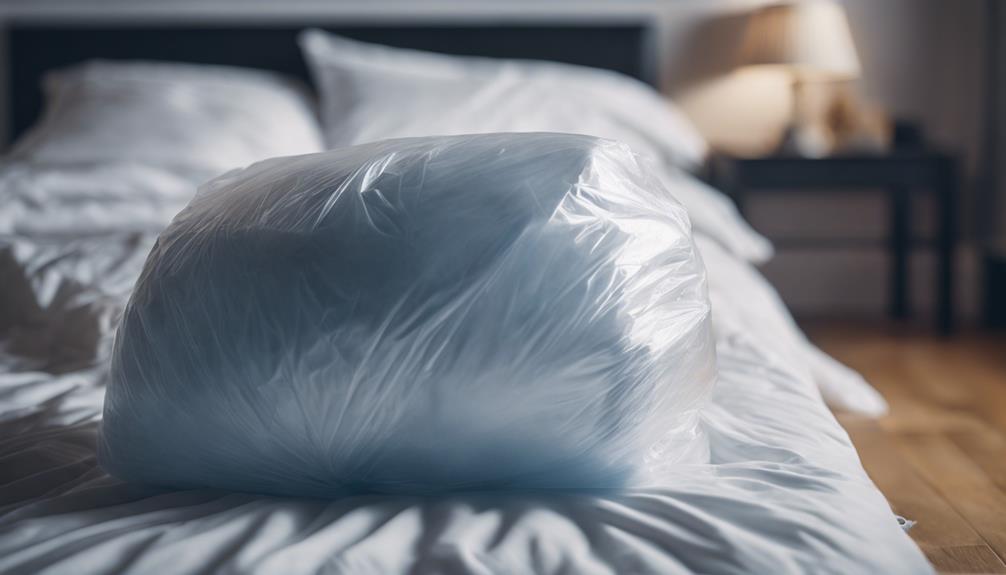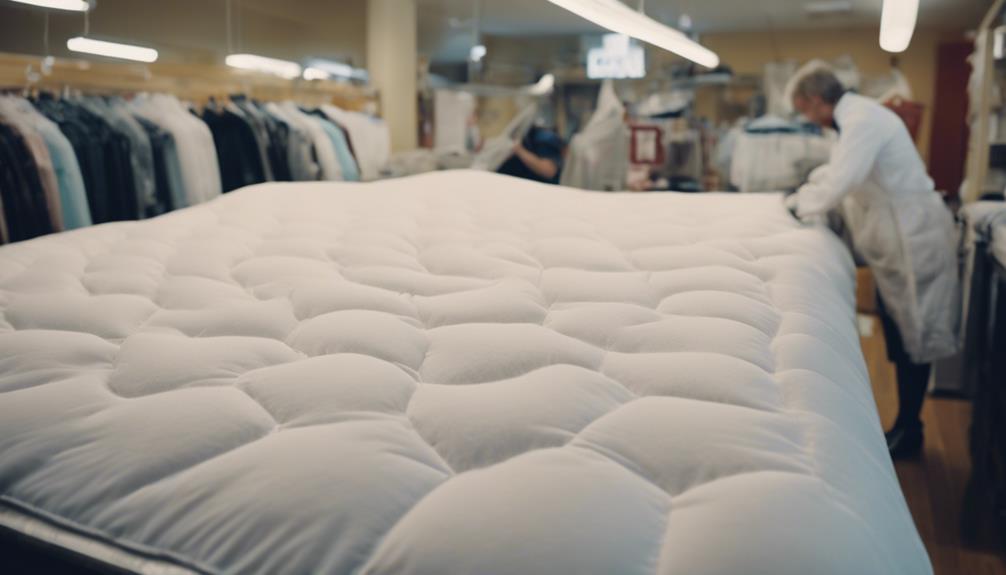Space bags have the potential to damage comforters by compressing fibers, resulting in reduced fluffiness and insulation. Vigorous compression within these bags can lead to permanent creases, altering the comforter’s original shape and comfort. It is important to exercise caution with delicate materials like down, as excessive compression can cause lasting harm. If you are interested in learning about the effects of using space bags to store comforters, it is essential to prioritize quality preservation and proper techniques. Additional information is available on how to prolong your comforter’s lifespan and insulation properties without compromising its integrity.
Key Takeaways
- Compression in space bags damages comforter fibers and reduces fluffiness.
- Excessive compression leads to permanent wrinkles and loss of loftiness.
- Avoid using space bags for down or feather bedding to prevent damage.
- Proper storage techniques maintain comforter quality and insulation properties.
- Opt for breathable storage alternatives to preserve delicate fibers and prevent compression effects.
Potential Damage to Comforter Fibers
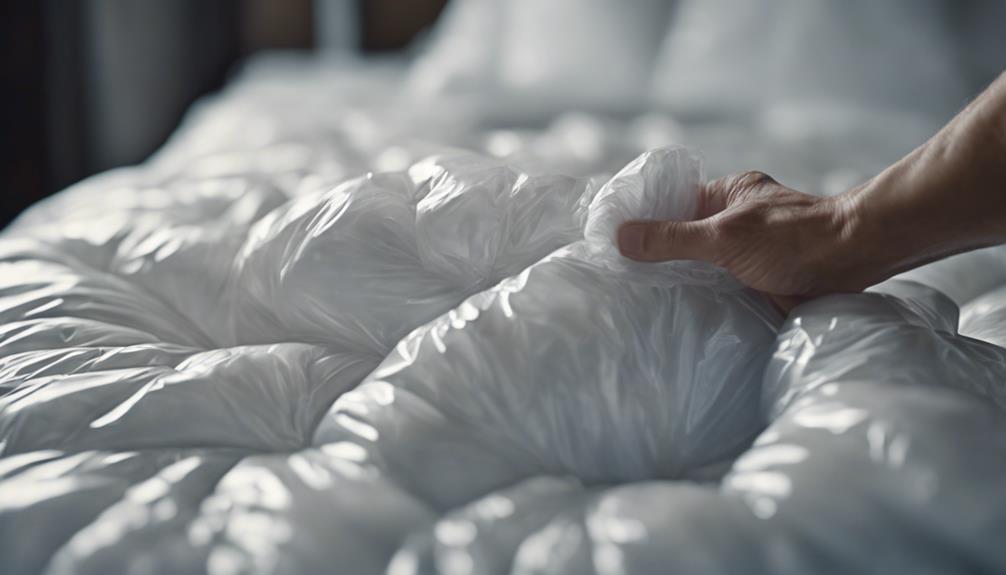
When storing comforters in vacuum bags, we risk damaging the fibers and reducing their fluffiness due to excessive compression. Comforters, especially those made of natural fibers like down, are susceptible to damage when compressed in vacuum storage bags for extended periods. The compression from the vacuum-sealing process can lead to a loss of loftiness in the comforter, affecting its overall comfort and warmth. These natural fibers are delicate and can suffer permanent creases and wrinkles when compressed, impacting the insulating properties of the comforter.
To prevent damage to the fibers and maintain the fluffiness of your comforter, it's advisable to avoid storing them in vacuum bags for prolonged periods. Excessive compression in space bags can't only ruin the original loftiness of the comforter but also diminish its insulation effectiveness over time. By understanding the potential harm that vacuum storage bags can cause to comforters, we can take proactive steps to preserve the quality and longevity of our bedding.
Understanding Compression in Space Bags
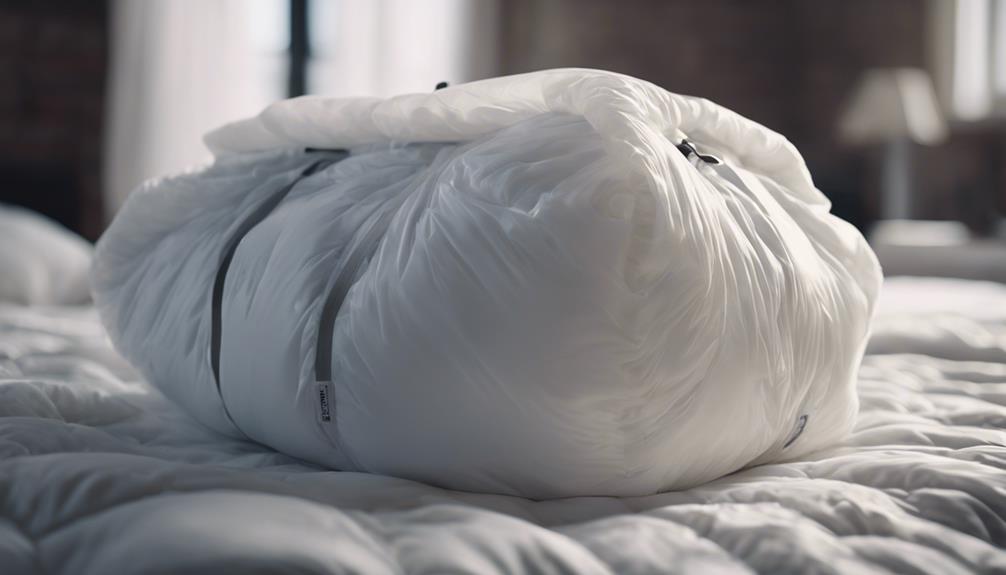
Space bags compress bedding tightly, potentially damaging the structure and fluffiness of comforters over time. When it comes to using vacuum storage bags for comforters, it's important to grasp the effects of compression on these bedding essentials. Here are some key points to keep in mind:
- Excessive compression in space bags can lead to the flattening of down and synthetic fibers in comforters, impacting their ability to provide insulation and warmth.
- Sharp folds and creases caused by the tight compression in space bags can result in permanent wrinkles on comforters, affecting their overall appearance.
- Prolonged storage in space bags may cause comforters to lose their loftiness and warmth over time, diminishing their quality and comfort.
- Using space bags for long-term storage of comforters isn't recommended if you want to maintain the fluffiness and structure of your bedding for an extended period.
Understanding how compression affects comforters in vacuum storage bags is essential for preserving their quality during storage.
Proper Use of Vacuum Storage Bags

Utilizing vacuum storage bags correctly can effectively compress comforters for convenient storage while safeguarding their integrity.
When using vacuum storage bags, it's important to follow proper guidelines to guarantee the protection of your comforters.
Avoid fully compressing the comforter as this can potentially damage the fibers. Instead, leave some air inside the bag to help maintain the fluffiness of the comforter while still reducing its size for storage.
Properly sealing the bag is also vital in protecting the comforter from dust and pests.
Impact on Down and Feathers

When vacuum-sealing down or feather bedding in space bags, be cautious of the potential compression effects that may reduce the insulation properties of the feathers. Compacting down or feathers in vacuum bags can lead to a loss of fluffiness and loft, affecting the bedding's overall effectiveness.
Additionally, the use of vacuum storage bags on down or feather bedding can pose long-term storage concerns, potentially damaging these delicate materials over time.
Down Compression Effects
Compressing down or feathers in vacuum storage bags can greatly compromise the insulation properties of bedding. When down bedding is compressed in vacuum bags, several negative effects can occur:
- Loss of Fluffiness: Squashing down comforters can lead to a loss of loft and fluffiness, reducing their effectiveness in providing warmth.
- Clumping Feathers: Vacuum-sealing down bedding may cause the feathers to clump together, diminishing their ability to insulate.
- Quill Breakage: Compression in vacuum bags can break the brittle quills of feathers, decreasing their durability and lifespan.
- Long-Term Damage: Avoid storing down comforters in vacuum bags to preserve their quality and ensure long-term comfort.
Feather Insulation Compromise
Squashing down or feather bedding in vacuum bags can compromise the insulation properties, leading to a reduction in fluffiness and loftiness. When full feathers are compressed, their brittle quills may snap, affecting the bedding's ability to provide warmth and comfort. Using vacuum storage bags on down bedding can ruin its original quality and compromise its insulation, ultimately reducing its effectiveness. To avoid this issue, it's best to refrain from using vacuum storage bags for down or feather bedding. Here is a table highlighting the impact of vacuum storage bags on down and feather bedding:
| Impact of Vacuum Storage Bags on Down Bedding |
|---|
| Compromise Insulation |
| Ruin Fluffiness |
| Reduce Warmth |
Long-Term Storage Concerns
To maintain the long-term quality and effectiveness of down and feather comforters, it's advisable to refrain from storing them in vacuum bags. Here are some reasons why:
- Compressing feathers excessively in vacuum storage bags can lead to loss of fluffiness and insulation, compromising the comfort of the comforter.
- Over-compression may damage the delicate structure of down bedding, affecting its long-term quality and durability.
- Squashing down comforters in vacuum bags can result in permanent damage to the feathers, impacting their ability to provide warmth.
- Using vacuum bags for long-term storage of down comforters can compromise their loft and comfort, diminishing their effectiveness over time.
Avoiding Over-Compression

To maintain the quality and warmth of your comforters when using space bags, it's important to avoid over-compression, especially for delicate materials like down or feathers. Over-compression in vacuum storage bags can damage the structure of comforters, leading to a loss of fluffiness and insulation.
When comforters are tightly squeezed in space bags, the delicate materials within can be compromised, affecting their ability to provide adequate warmth and comfort. To prevent this, it's essential to avoid excessive compression that may alter the original shape and comfort of your comforters.
Opting for breathable cotton bags or storing comforters on closet shelves can be a better alternative to maintain the integrity of your bedding without subjecting them to the risks of over-compression. By being mindful of how you store your comforters, you can make sure that they remain in top condition for extended periods, ready to provide you with the comfort and warmth you desire.
Maintaining Fluffiness and Insulation
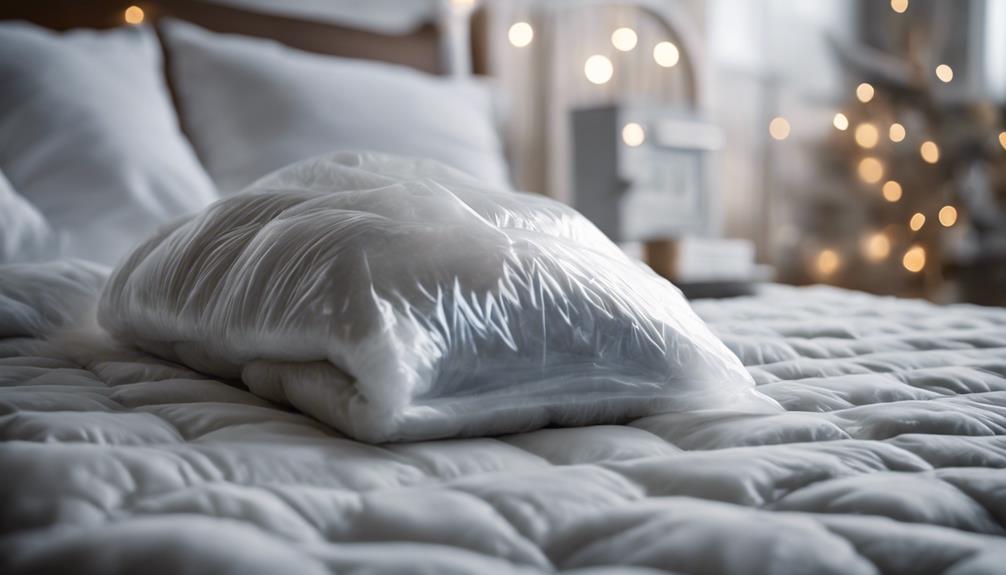
Maintaining the fluffiness and insulation of comforters is essential for ensuring their long-term quality and comfort. When it comes to using vacuum storage bags for comforters, it's important to take into account how compression can impact their loft and warmth retention. Here are some key points to keep in mind:
- Avoid Over-Compression: Excessive compression from vacuum-sealed bags can flatten the comforter, reducing its fluffiness and insulation.
- Impact on Loft: The compression from space bags can affect the loft of the comforter, diminishing its ability to provide warmth and comfort.
- Material Considerations: Feather or down comforters are particularly sensitive to compression and may lose their softness and warmth when stored in vacuum-sealed bags.
- Choose Breathable Storage: Opt for breathable storage options like cotton bags to help maintain the loft and effectiveness of the comforter over time.
Tips for Preserving Comforter Quality
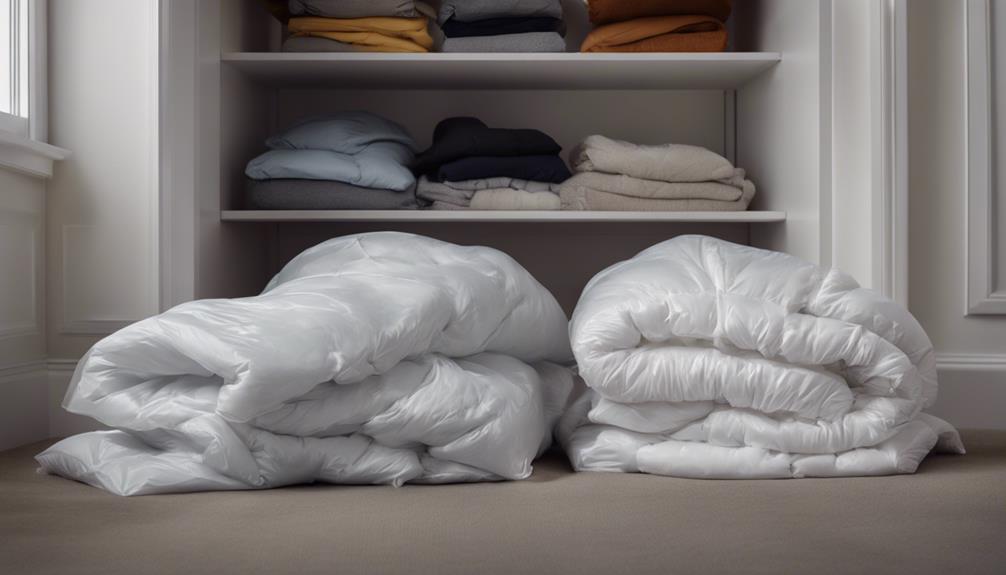
Preserving comforter quality requires careful consideration of storage methods and maintenance practices. When it comes to using vacuum storage bags for comforters, it's important to follow specific guidelines to guarantee their longevity.
To begin with, make sure your comforter is clean and completely dry before storing it in a vacuum-sealed bag. This step prevents any mold or mildew from forming while the comforter is tightly packed away. For down alternative comforters, vacuum-seal storage bags can be a space-saving solution, helping to maintain the fluffiness of the comforter.
However, it's essential to avoid compressing down comforters in these bags as it can damage the delicate feathers inside. By using vacuum storage bags correctly and with caution, you can effectively preserve the quality of your comforters for years to come.
Preventing Damage to Delicate Fibers
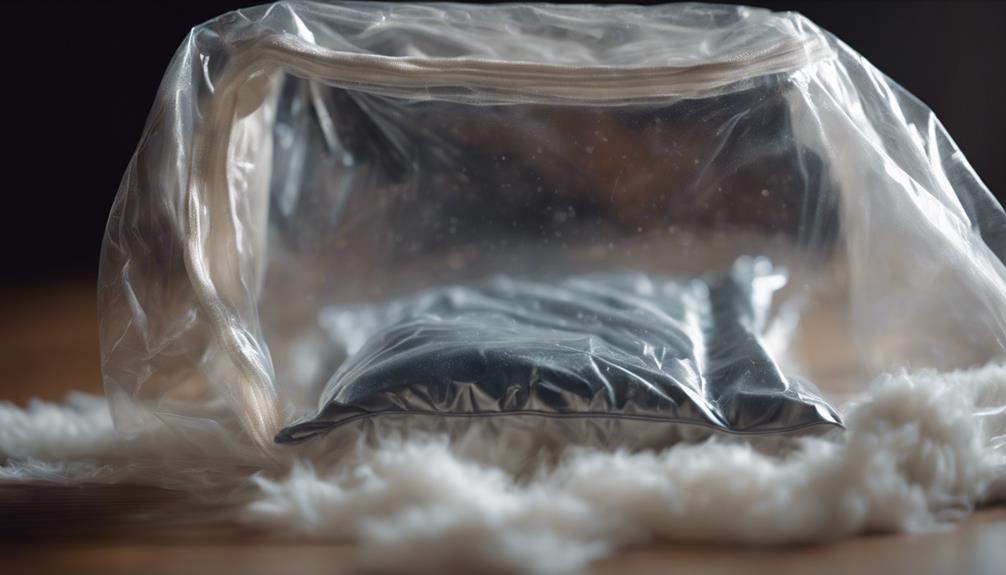
When handling delicate fibers such as silk or cashmere, it's important to avoid using space bags for storage. These fragile fabrics can suffer damage from the compression in space bags, leading to wrinkles and loss of softness.
To preserve the quality of delicate comforters, opt for gentle fabric handling, proper storage techniques, and fabric preservation tips.
Gentle Fabric Handling
To handle delicate fibers with care, consider choosing storage options that prioritize maintaining the integrity of the fabric. Cotton bags or breathable storage containers are good choices for this purpose. When it comes to storing down comforters or other items with delicate fibers, gentle fabric handling is important to prevent damage and promote longevity.
Here are some tips to help you protect your delicate fibers:
- Avoid vacuum storage bags: These can compress delicate fibers, affecting the fluffiness and insulation properties.
- Use cotton bags: Opt for breathable materials like cotton to allow air circulation and prevent moisture buildup.
- Select breathable storage containers: Containers that allow airflow can help maintain the quality of delicate fibers.
- Consider alternative storage solutions: Explore options beyond compression-based storage to preserve the integrity of your fabrics.
Proper Storage Techniques
Implementing proper storage techniques is essential for safeguarding delicate fibers from damage and preserving their quality over time.
When it comes to down comforters, avoid using vacuum storage bags as they can compress feathers and harm the insulation. Opt for large cotton bags instead, allowing the fibers to breathe and preventing them from being squashed. Never stack anything on top of a down comforter to maintain its fluffiness and original quality.
Vacuum bags that fully compress feathers can ruin the loft and insulating properties of down bedding. By following these proper storage techniques, you can help preserve the quality and effectiveness of expensive down or feather comforters for years to come.
Fabric Preservation Tips
Preserving delicate fibers, such as silk and cashmere, requires careful consideration to avoid damage and maintain quality over time. When it comes to fabric care and preservation, here are some essential tips to protect your delicate comforters:
- Avoid Vacuum Storage Bags: Refrain from using vacuum storage bags on delicate fibers to prevent compression and maintain the fabric's integrity.
- Opt for Cotton Bags: Choose cotton storage bags or acid-free containers instead of vacuum bags to safeguard delicate comforters from damage.
- Prevent Permanent Wrinkles: Vacuum-sealing natural fibers can lead to permanent wrinkles and creases, impacting the overall appearance and feel of the fabric.
- Proper Storage Methods: Implement proper storage techniques to guarantee the longevity of delicate fibers and preserve the quality of your comforters.
Frequently Asked Questions
Do Space Bags Cause Color Fading on Comforters?
Space bags can potentially cause color fading on comforters due to prolonged compression and lack of airflow. To prevent this, consider placing a protective barrier like a cotton sheet between the comforter and the space bag before vacuum sealing.
This can help mitigate direct contact and minimize the risk of color transfer or fading. Regularly airing out the comforter and storing it in a cool, dry place can also help maintain its color vibrancy.
Can Vacuum Storage Bags Trap Moisture Inside?
Vacuum storage bags can indeed trap moisture inside. This can happen if the bags aren't properly sealed or if there's existing moisture in the items being stored.
To prevent this issue, make sure to carefully seal the bags and guarantee that the items inside are completely dry before storing them. Additionally, consider adding a moisture absorber like silica gel packets to help maintain a dry environment within the bags.
Will Compression Affect the Loft of Down Comforters?
Compression can affect the loft of down comforters. When stored in vacuum bags, the down filling can become flattened, reducing its ability to trap air and provide warmth.
Over time, this compression may impact the overall fluffiness and insulation properties of the comforter.
To maintain the loft of down comforters, it's advisable to store them in a breathable cotton storage bag or on a hanger in a well-ventilated area.
How Do I Prevent Mold Growth in Compressed Comforters?
To prevent mold growth in compressed comforters, it is important to take several precautions:
- Ensure the comforters are completely dry before storage.
- Use desiccants in the storage area.
- Air out the comforter periodically.
Avoid storing in damp or humid spaces. Consider using breathable storage containers or bags to allow for air circulation. Regularly inspect the comforter for any signs of moisture or mold.
Mold can be a real hassle, but with proper care, we can keep our comforters fresh and mold-free.
Can Space Bags Lead to Permanent Wrinkles in Comforters?
Space bags can lead to permanent wrinkles in comforters if not packed properly.
To prevent this issue, make sure to fold the comforter neatly before placing it in the space bag.
Smooth out any wrinkles and avoid overstuffing the bag, as this can cause excessive compression.
Once the comforter is properly packed, seal the bag tightly to minimize air exposure.
Following these steps will help maintain the integrity of your comforter.
Are Space Bags and Vacuum Seal Bags Equally Damaging to Comforters?
Space bags and vacuum seal bags can potentially damage comforters if used incorrectly. The high pressure from vacuum seal bags can compress the filling and weaken the fabric over time. It’s best to use breathable storage options for comforters to avoid any potential damage.
Conclusion
To sum up, while space bags can be a convenient storage solution for comforters, it's important to use them properly to avoid damaging the fibers. By understanding compression, avoiding over-compression, and following tips for preserving comforter quality, you can maintain the fluffiness and insulation of your bedding.
Remember to handle delicate fibers with care to prevent any potential damage. So, keep these tips in mind to guarantee your comforter stays in top condition for years to come.
